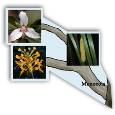Monocots
 The Monocots have only one seedling leaf (cotyledon) and usually have scattered vascular
bundles, parallel veined leaves, and flower parts borne in multiples of three. There
are no truly "woody" monocots, as they are incapable of secondary growth that would
produce wood, but Monocot "trees" such as bananas and palms manage to form trunks
via other mechanisms, such as lignified vasculature or leaf bases. Monocots include
the grass family, the most economically and evolutionarily important plant family
to humans (corn, wheat, rice, oats, barley, etc.). Some relationships between Monocot
families are still somewhat unresolved, even with all current molecular and morphological
data, but a much clearer picture of Monocot phylogeny has emerged in the last 8 years.
Morphologically, it has been historically problematic to classify Liliales, Asparagales,
and other orders with similar basic monocot floral structure (see discussion under
Liliaceae). Within Monocots, there are many interesting modifications to the angiosperm
flower, from the highly reduced, wind-pollinated grasses and sedges, to the highly
specialized and elaborate flowers seen in orchids.
The Monocots have only one seedling leaf (cotyledon) and usually have scattered vascular
bundles, parallel veined leaves, and flower parts borne in multiples of three. There
are no truly "woody" monocots, as they are incapable of secondary growth that would
produce wood, but Monocot "trees" such as bananas and palms manage to form trunks
via other mechanisms, such as lignified vasculature or leaf bases. Monocots include
the grass family, the most economically and evolutionarily important plant family
to humans (corn, wheat, rice, oats, barley, etc.). Some relationships between Monocot
families are still somewhat unresolved, even with all current molecular and morphological
data, but a much clearer picture of Monocot phylogeny has emerged in the last 8 years.
Morphologically, it has been historically problematic to classify Liliales, Asparagales,
and other orders with similar basic monocot floral structure (see discussion under
Liliaceae). Within Monocots, there are many interesting modifications to the angiosperm
flower, from the highly reduced, wind-pollinated grasses and sedges, to the highly
specialized and elaborate flowers seen in orchids.
The genus Acorus is the sister group to all other Monocots and produces ethereal oils with a similar "primitive" odor to Magnoliids and Austrobaileyales. Like the basal angiosperms, monocots produce monosulcate or monoporate pollen (pollen with only one groove or pore).
More information coming soon...









